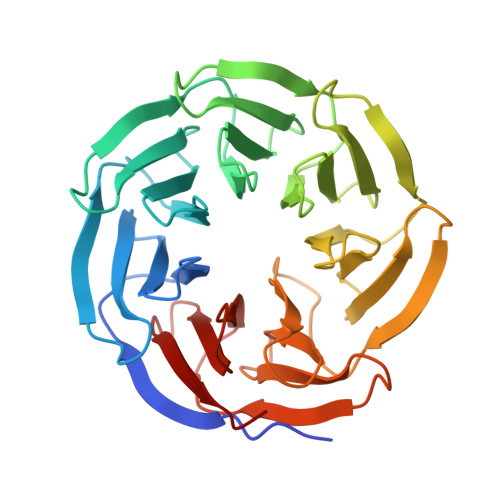Structure-Based Optimization of a Small Molecule Antagonist of the Interaction Between WD Repeat-Containing Protein 5 (WDR5) and Mixed-Lineage Leukemia 1 (MLL1).
Getlik, M., Smil, D., Zepeda-Velazquez, C., Bolshan, Y., Poda, G., Wu, H., Dong, A., Kuznetsova, E., Marcellus, R., Senisterra, G., Dombrovski, L., Hajian, T., Kiyota, T., Schapira, M., Arrowsmith, C.H., Brown, P.J., Vedadi, M., Al-Awar, R.(2016) J Med Chem 59: 2478-2496
- PubMed: 26958703
- DOI: https://doi.org/10.1021/acs.jmedchem.5b01630
- Primary Citation of Related Structures:
5EAM, 5EAP, 5EAR - PubMed Abstract:
WD repeat-containing protein 5 (WDR5) is an important component of the multiprotein complex essential for activating mixed-lineage leukemia 1 (MLL1). Rearrangement of the MLL1 gene is associated with onset and progression of acute myeloid and lymphoblastic leukemias, and targeting the WDR5-MLL1 interaction may result in new cancer therapeutics. Our previous work showed that binding of small molecule ligands to WDR5 can modulate its interaction with MLL1, suppressing MLL1 methyltransferase activity. Initial structure-activity relationship studies identified N-(2-(4-methylpiperazin-1-yl)-5-substituted-phenyl) benzamides as potent and selective antagonists of this protein-protein interaction. Guided by crystal structure data and supported by in silico library design, we optimized the scaffold by varying the C-1 benzamide and C-5 substituents. This allowed us to develop the first highly potent (Kdisp < 100 nM) small molecule antagonists of the WDR5-MLL1 interaction and demonstrate that N-(4-(4-methylpiperazin-1-yl)-3'-(morpholinomethyl)-[1,1'-biphenyl]-3-yl)-6-oxo-4-(trifluoromethyl)-1,6-dihydropyridine-3-carboxamide 16d (OICR-9429) is a potent and selective chemical probe suitable to help dissect the biological role of WDR5.
- Drug Discovery Program, Ontario Institute for Cancer Research , 661 University Avenue, MaRS Centre, West Tower, Toronto, Ontario M5G 0A3, Canada.
Organizational Affiliation:




















